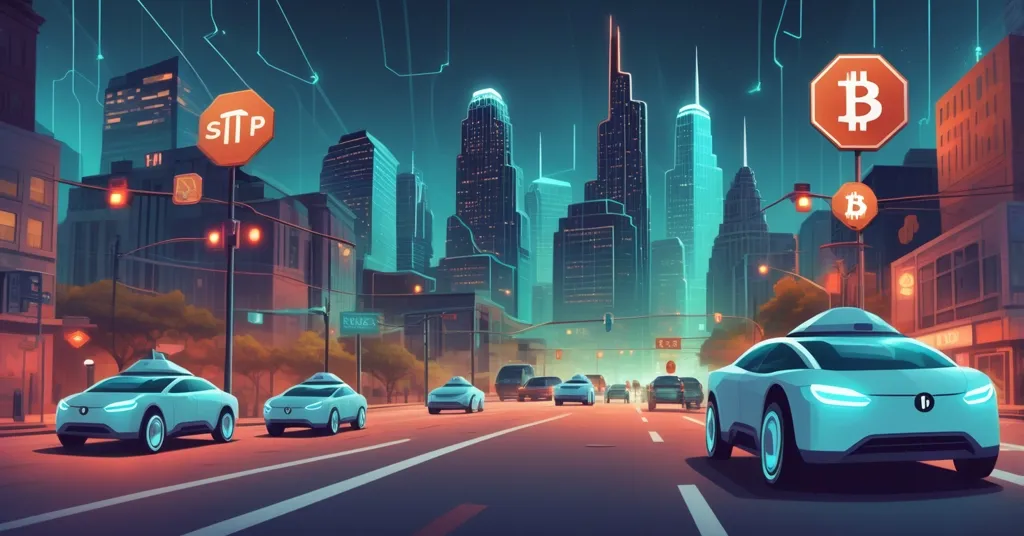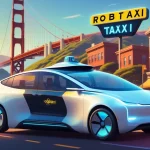Tesla Robotaxi Delay in Texas Sparks Safety Debate and Bitcoin Regulation Parallels

Tesla Robotaxi Delay in Texas: Innovation vs. Safety Mirrors Bitcoin Regulatory Battles
Elon Musk’s grand vision to launch Tesla’s robotaxi service in Austin on June 22, 2025, has slammed into a regulatory wall as Texas lawmakers demand a delay until September, when stricter autonomous driving laws take effect. This clash between cutting-edge tech and public safety concerns feels like a replay of the battles Bitcoin and blockchain pioneers have fought for years—disruption charging ahead while governance scrambles to catch up.
- Regulatory Roadblock: Texas lawmakers urge Tesla to postpone robotaxi rollout until new safety laws kick in.
- Safety Under Fire: Critical tests and federal scrutiny question Tesla’s readiness for driverless streets.
- Crypto Parallels: Tesla’s push mirrors Bitcoin’s struggle with innovation outpacing regulation.
Texas Lawmakers Draw the Line on Tesla’s Robotaxi Plan
On June 18, a coalition of Texas House and Senate members signed a letter pressing Tesla to delay its robotaxi debut in Austin. The sticking point? New state regulations set to roll out in September that will impose a much-needed framework for autonomous vehicles. These rules aren’t just red tape—they mandate registration, adherence to strict safety and vehicle standards, and the ability for a car to enter a “minimal risk condition” if its system fails. For those new to the term, this means the vehicle can safely pull over or stop on its own during a glitch, like an emergency brake for driverless tech. Companies will also need to submit a First Responder Interaction Plan, ensuring emergency services know how to handle these vehicles in a crisis. You can explore more about these upcoming Texas autonomous vehicle regulations for September 2025 and Tesla’s compliance challenges.
Right now, Texas is a regulatory Wild West for autonomous tech, requiring only basic registration and insurance. That’s made it a magnet for heavyweights like Tesla, Waymo, Zoox, Volkswagen, and Hyundai to test and deploy their driverless dreams. But with public safety on the line, lawmakers argue that waiting a few months for tighter oversight isn’t too much to ask. Texas lawmaker Goodwin didn’t hold back on CBS Austin when addressing Tesla’s readiness:
“I don’t know that it is ready to be launched. There is more work that needs to be done before they let them loose on the streets.”
This skepticism isn’t just political posturing—it’s rooted in real concerns about whether Tesla’s tech can handle the unpredictability of real-world roads before the new rules provide a safety net. For deeper insights into the push for delay, check out this story on local Texas lawmakers demanding a postponement of Musk’s robotaxi launch.
Tesla’s Safety Under Scrutiny: Red Flags and Federal Heat
Tesla has been testing its driverless tech on Austin streets for the past month, with sightings of a Model Y cruising without a human behind the wheel. These tests operate under geofenced limits—meaning the car sticks to a specific, pre-mapped area—and with remote monitoring, where a human can oversee or intervene from afar, as shown in a video Elon Musk posted on X. Musk’s plan, unveiled in May, aims to deploy thousands of robotaxis starting in Austin, with eyes on expanding to cities like San Francisco. It’s a bold bet on a future where personal car ownership fades, much like Bitcoin challenges centralized banking. Learn more about Tesla’s autonomous vehicle technology for context on their ambitious project.
But the road to that future is littered with potholes. A scathing test by The Dawn Project, a group critical of Tesla’s self-driving tech, revealed a Model Y with Full Self-Driving (FSD) software failing to stop for a school bus sign—even with a child-sized dummy in the frame. This isn’t just bad optics; it’s a glaring safety lapse. For a detailed breakdown, see this analysis of Tesla robotaxi safety test failures involving a school bus incident. Protests planned by The Dawn Project and anti-Musk groups in Austin on June 12 further amplify the public unease. On top of that, the National Highway Traffic Safety Administration (NHTSA)—the U.S. agency enforcing vehicle safety with the power to recall or halt deployments—sent Tesla a letter in May demanding details on how robotaxis manage collisions, poor visibility, and emergencies. Tesla’s response was due by June 19, adding pressure to an already tight timeline.
Austin: The Wild West of Autonomous Tech
Tesla zeroed in on Austin for a damn good reason—minimal red tape. Texas’s light-touch approach, especially under a Republican-dominated legislature and governor, has positioned the state as a hub for autonomous vehicle innovation. Until September, the rules are bare-bones, inviting rapid testing and deployment. It’s a setup that screams opportunity for companies pushing the envelope, not unlike how early Bitcoin innovation thrived in jurisdictions with little to no blockchain regulation. Austin residents have mixed feelings—some are thrilled by the sci-fi spectacle of driverless cars, while others dread the idea of a glitch turning their commute into a demolition derby. Community opinions on these Tesla robotaxi safety concerns in Texas are widely discussed online.
Yet, this leniency cuts both ways. While it fuels speed, it heightens the risk of mishaps. A single high-profile accident could spark a backlash akin to the public outcry over crypto scams in unregulated spaces, torching trust overnight. Texas’s gamble on being a tech-friendly haven mirrors the early days of crypto havens, where decentralized technology risks were ignored until disaster struck. The question is whether Tesla can navigate this freedom without crashing—literally or figuratively—before stricter guardrails are in place.
Musk’s Power Play: Safety Claims and Political Leverage
Elon Musk isn’t one to back down from a challenge, and he’s doubling down on Tesla’s commitment to safety with his usual flair. On X, on June 10, he addressed concerns directly, as covered in these statements on Tesla robotaxi launch delays and safety issues:
“We are being super paranoid about safety, so the date could shift.”
Musk claiming to be “super paranoid” about safety is a bit like a Bitcoin whale swearing they’re risk-averse—believe it when you see it. Still, his willingness to adjust the June 22 launch date hints at flexibility, potentially aligning with lawmakers’ September deadline if safety isn’t ironclad. Musk’s influence doesn’t stop at Tesla, though. With his role leading the Department of Government Efficiency and hefty political campaign contributions, some speculate he’s got the clout to nudge regulatory outcomes in Texas or beyond. Whether that means Texas bends for Tesla or Tesla bends for Texas is anyone’s guess. Public opinion on these safety issues and trust in Tesla’s robotaxi tech remains a hot topic.
Tesla’s also lobbying for unified federal rules to avoid the mess of state-by-state laws, a move reminiscent of the crypto industry’s push for consistent U.S. policy over fragmented state regulations like New York’s BitLicense. Meanwhile, NHTSA’s efforts to fast-track approvals for vehicles without traditional controls—think Tesla’s futuristic CyberCab—suggest the feds might lean toward effective accelerationism (e/acc), a philosophy advocating for speeding up tech progress to solve societal issues faster, much like some Bitcoin maximalists champion pure decentralization despite the chaos it can bring.
What Crypto Teaches Us About Disruption
This isn’t just a story about robotaxis—it’s a window into the messy dance between disruptive tech and the slow grind of governance. Tesla’s battle in Texas echoes Bitcoin’s own regulatory wars, from the U.S. Infrastructure Bill’s crypto tax provisions to ongoing SEC clashes with blockchain projects. Both fields pit innovation against oversight, forcing a balance between accelerating progress and shielding the public from untested risks. Just as Bitcoin’s early adopters thrived in unregulated spaces, Tesla’s rush to deploy in a regulation-light state like Texas embodies the e/acc ethos—push hard, push fast, and fix the fallout later. But every day of delay in autonomous tech is another day of human-driven crashes, much like Bitcoin’s regulatory roadblocks delay financial freedom for millions. For a thought-provoking comparison, see this piece on parallels between Bitcoin regulation and autonomous tech innovation.
There’s potential for deeper intersection here, too. Imagine a future where robotaxi fleets run on decentralized payment systems, with rides paid in Bitcoin or Ethereum via tokenized ride-sharing economies. Blockchain could secure autonomous vehicle data or verify safety logs, marrying these disruptive technologies. It’s speculative, sure, but it’s the kind of out-of-the-box thinking that drives both crypto and autonomous tech forward.
Let’s not kid ourselves—Tesla’s got a history of overpromising on Full Self-Driving, with “full autonomy” always just around the corner for years. If robotaxis flop due to safety failures, it could gut public trust in autonomous tech the way shady ICOs stained crypto’s reputation in 2017. But if Tesla pulls this off, it’s a defiant middle finger to the status quo, proving rapid innovation can outpace bureaucratic drag. That’s a win for e/acc advocates and a parallel to Bitcoin’s rebellion against central banks. The verdict’s still pending on whether Austin’s streets crown Tesla king or crush its ambitions. Will this gamble pave the way for true disruption, or crash like a leveraged altcoin in a bear market?
Key Takeaways and Burning Questions
- Why are Texas lawmakers pushing Tesla to delay the robotaxi launch?
They’re worried about public safety and want Tesla to wait until September, when new laws enforce stricter registration, safety standards, and emergency protocols for autonomous vehicles. - What safety issues are critics highlighting about Tesla’s tech?
Tests like The Dawn Project’s show Tesla’s Full Self-Driving failing basic checks, such as stopping for a school bus, while NHTSA inquiries question readiness for collisions and emergencies. - How does Texas’s regulatory stance impact this situation?
Texas’s minimal rules have made it a hotspot for autonomous vehicle testing, but this leniency fuels safety concerns, mirroring crypto’s early regulatory Wild West days. - Could Tesla still launch on June 22 despite the pushback?
It’s possible—Musk has hinted at flexibility on timing, and Tesla’s political leverage in a deregulation-friendly state might allow a launch if safety is demonstrably addressed. - How does Tesla’s robotaxi launch relate to Bitcoin’s regulatory struggles?
Both showcase innovation outpacing regulation, with Tesla’s rapid deployment in Texas reflecting Bitcoin’s push for adoption despite fragmented oversight, highlighting the tension between progress and protection. - What can Tesla learn from crypto’s regulatory battles?
Bitcoin’s fight for legitimacy shows that balancing innovation with public trust is key—Tesla must prove safety transparently, just as blockchain projects must combat scams to win mainstream acceptance.


